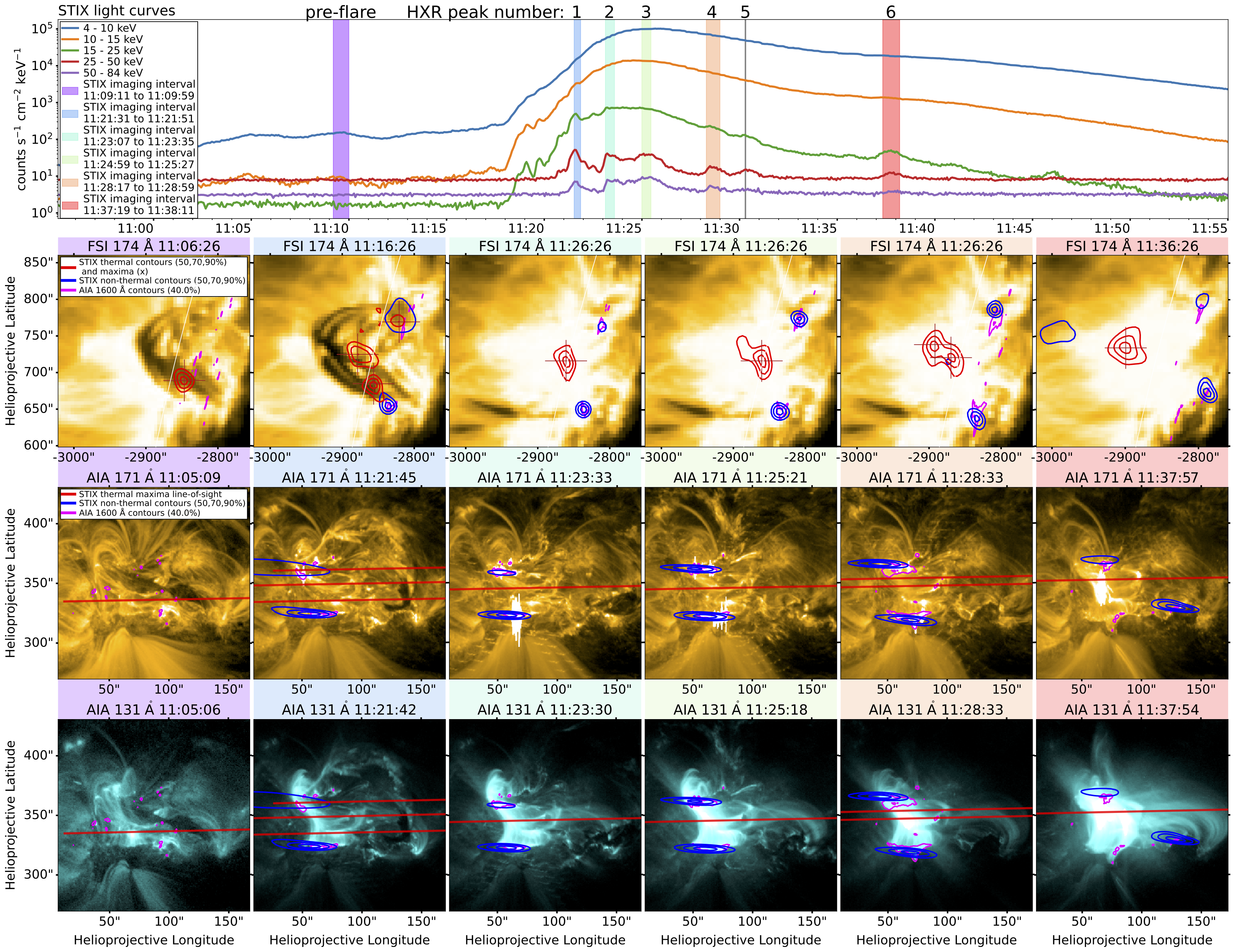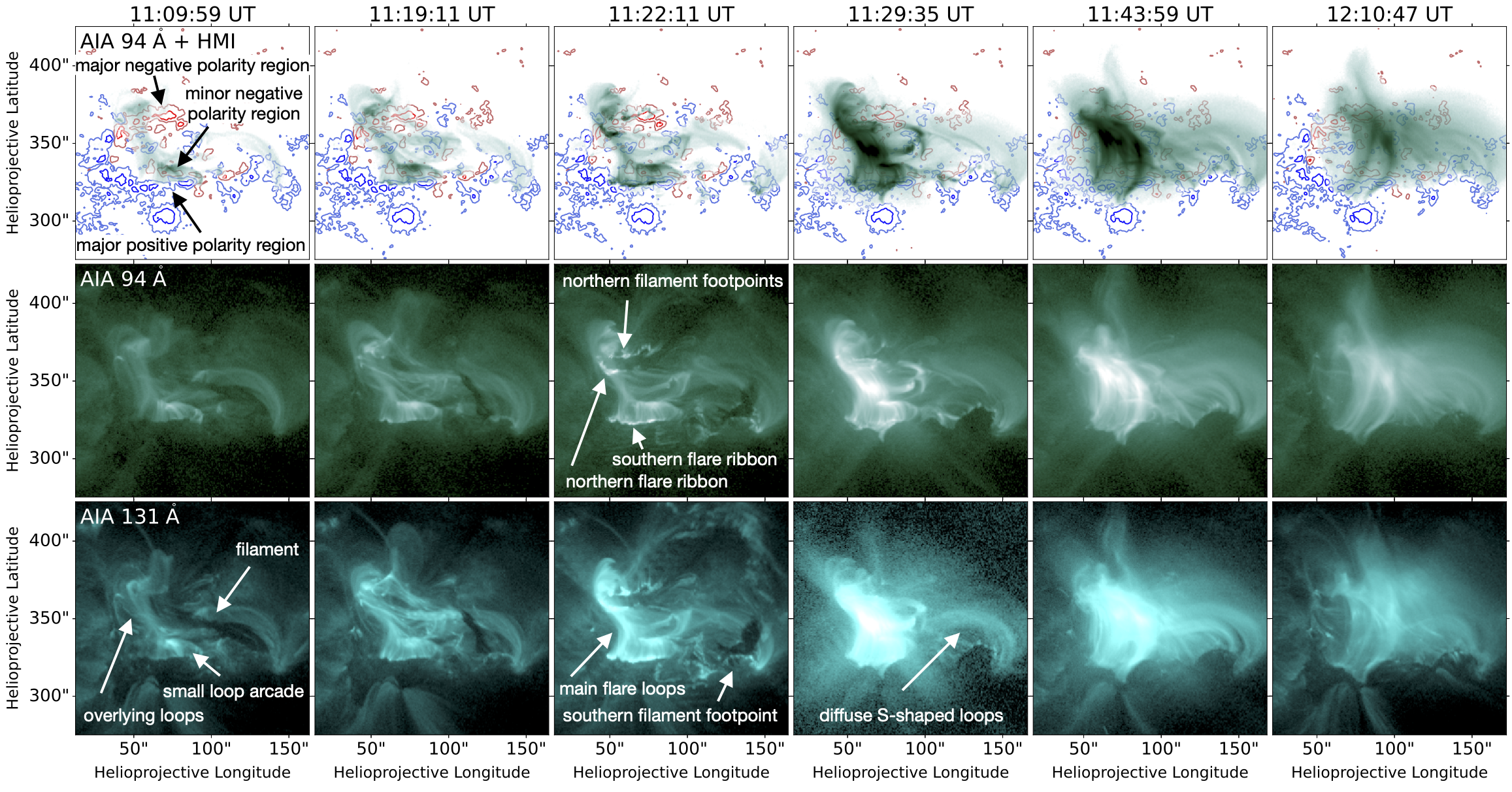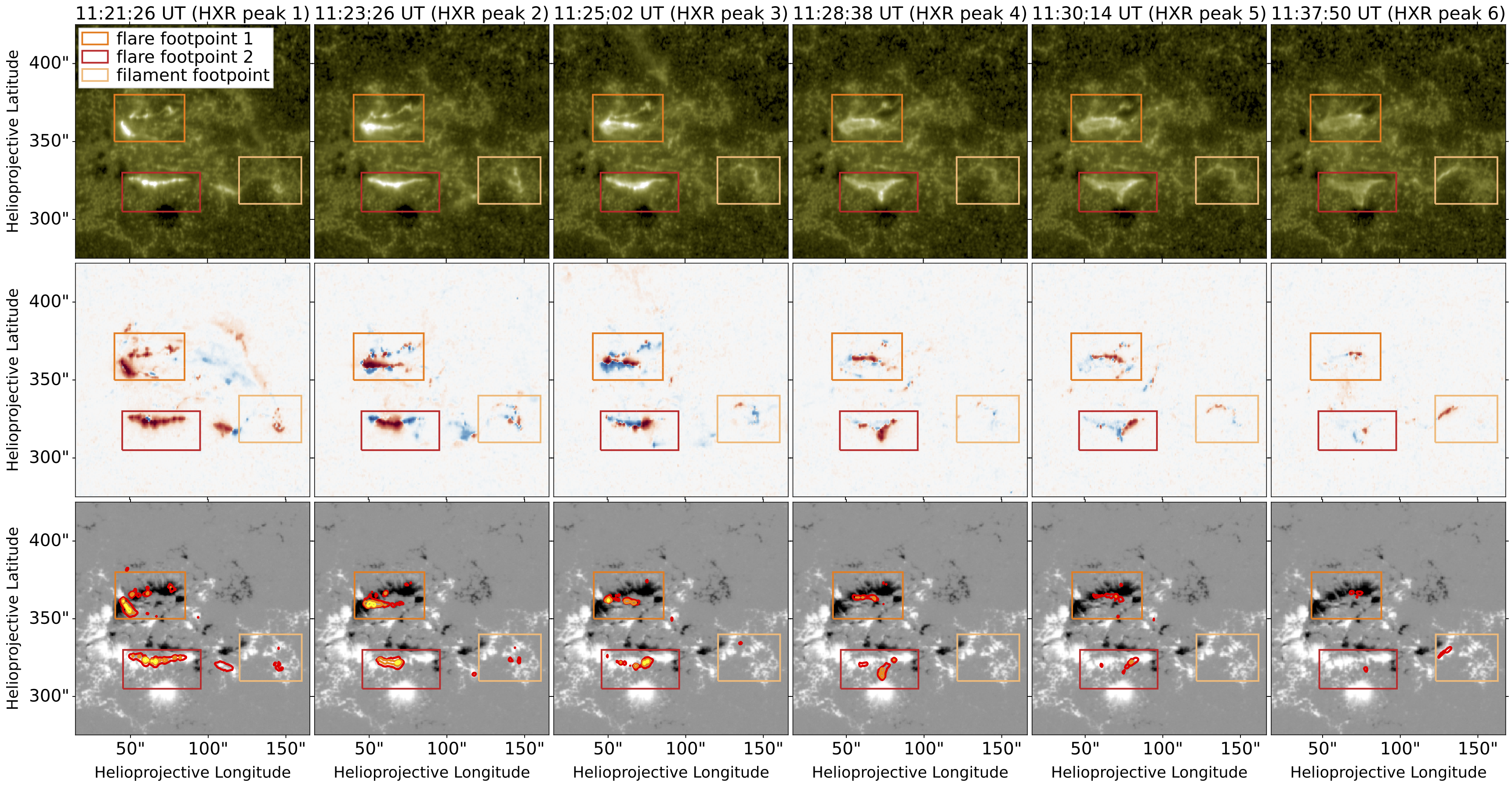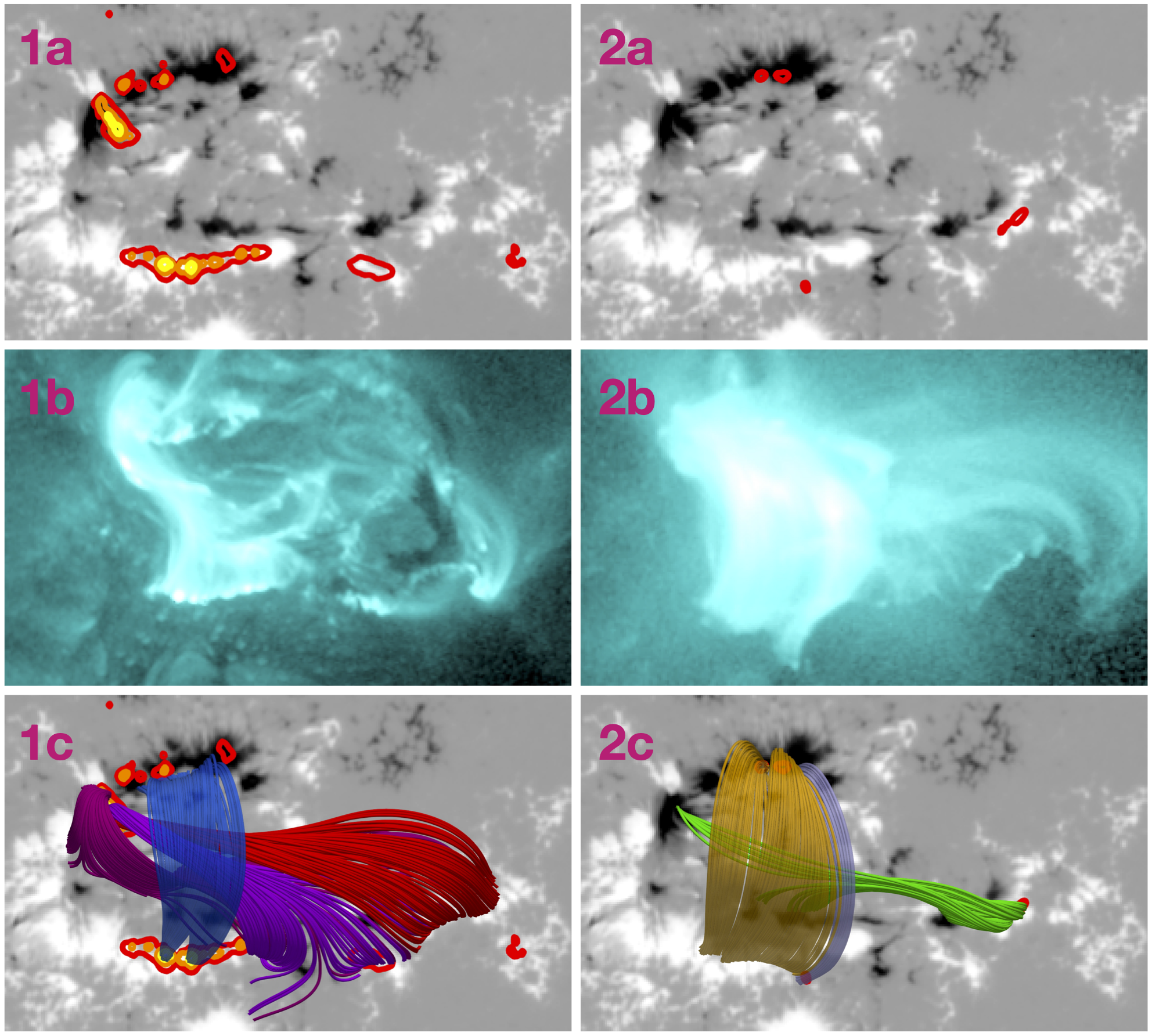Science nugget: Understanding STIX hard X-ray source motions using field extrapolations - Solar Orbiter
UNDERSTANDING STIX HARD X-RAY SOURCE MOTIONS USING FIELD EXTRAPOLATIONS
(Solar Orbiter nugget #24 by S. Purkhart1, A. M. Veronig1,2, E. C. M. Dickson1, A. F. Battaglia3,4, S. Krucker3,5, R. Jarolim1, B. Kliem6, K.Dissauer7, T. Podladchikova8)
Introduction
We present key results of a case study [1] of an M4-class flare on March 28, 2022, seen by STIX and EUI/FSI onboard Solar Orbiter, and SDO/AIA. An interesting aspect of this flare was the change in the non-thermal hard X-ray (HXR) source configuration during a late HXR peak, changing from the classical two footpoints at the ends of the flaring loops to a dominant source at one of the anchor points of the erupting filament.
The event occurred when Solar Orbiter was at a distance of 0.33 AU from the Sun and at a longitudinal separation of 83.5° west of the Sun-Earth line, close to its first science perihelion. From Solar Orbiters perspective, the event appeared near the eastern limb, while Earth-orbiting spacecraft observed it near the disk center.
Evolution of STIX X-ray sources
Figure 1 shows the evolution of the STIX X-ray sources mapped onto Solar Orbiter/EUI and SDO/AIA images. Initially, the event appears consistent with the standard flare model, with thermal emission from the flare loops and two non-thermal footpoints at their ends. However, during the last HXR burst (number 6), the southern non-thermal footpoint changes to a different location. Reprojections to SDO/AIA reveal that this new non-thermal HXR source is located at the edge of the southern anchor point of the erupting filament.

Figure 1. Overview of STIX HXR sources and their relation to Solar Orbiter/EUI and SDO/AIA images. Top row: STIX light curves for five energy ranges from 4 to 84 keV. Imaging intervals are marked by different colors. Columns: Color-coded corresponding to the marked time intervals containing the following observations: 1) STIX clean image contours on top of the closest available EUI FSI 174 Å image. Maxima of thermal contours are marked. 2) AIA 171 Å image with reprojected STIX non-thermal contours and the line-of-sights through the maxima of STIX thermal sources. 3) same as 2) but with AIA 131 Å images.
Event overview in the EUV
A more extensive overview of the AIA observations is shown in Fig. 2. The filament eruption appears asymmetric, with a more active, upward-whipping leg in the north and a more anchored leg in the south. The main flare loop arcade starts very narrow and then rapidly expands westward. This westward motion continues throughout the flare, and after the final HXR burst, flare loops appear that connect to the region of the southern filament footpoint.

Figure 2. Event overview in the AIA 94 Å and 131 Å channels at six selected times (columns). The top row shows inverted AIA 94 Å images together with HMI line-of-sight magnetogram contours marking levels of ±200 and ±1000 G for negative (red) and positive (blue) polarity.
Chromospheric response in the UV
Following the evolution of the AIA 1600 Å enhancements during the major HXR peaks (see Fig. 3), we again observe a westward motion throughout the flare. During the final HXR peak, the southern AIA 1600 Å enhancement jumps to the edge of the erupting filament's anchor point, confirming the location of the STIX non-thermal footpoint. A time series analysis of the AIA 1600 Å intensities in the marked subregions confirmed a close correlation with the timing of the HXR bursts observed by STIX.

Figure 3. Overview of AIA 1600 Å observations and their relation to HMI. Top row: AIA 1600 Å images during the HXR peaks for six time steps. Colored rectangles mark subregions encompassing the northern footpoints of the filament and northern flare ribbon (orange), the southern flare ribbon (red), and the southern filament footpoint (yellow). Middle row: Running-difference images of the above frames relative to the AIA 1600 Å image recorded 48 s earlier. Red (blue) colors indicate emission increase (decrease). Bottom row: Contours of emission increase in the running difference images above drawn on top of the HMI line-of-sight magnetograms. An animation of Figure 3 is available at the bottom of this nugget.
Nonlinear force-free magnetic field extrapolation
We related the AIA 1600 Å footpoints to structures in a pre-flare nonlinear force-free (NLFF) magnetic field extrapolation obtained using a physics-informed neural network approach [2]. By starting magnetic field line tracers within the contours of AIA 1600 Å enhancements associated with HXR bursts, we identify structures that were likely involved in magnetic reconnection during that time.
In Fig. 4 we show the pre-flare configuration of magnetic field structures likely involved in reconnection during HXR burst 1 (panels 1a to 1c) and HXR burst 6 (panels 2a to 2c). The first HXR burst resulted primarily from reconnection between a weakly sheared arcade (blue) and strongly sheared field lines (red/purple) near the erupting filament structure. This reconnection probably gave rise to the narrow AIA 131 Å flare loop arcade, which expanded westward during subsequent HXR bursts. During the final HXR burst, field lines (green) near the filament structure, which were initially strongly sheared and connected to the primary AIA 1600 Å emission kernel during the first HXR peak, were again involved.

Figure 4. Comparison of pre-flare magnetic field structures involved in the first and last HXR peaks. 1a and 2a: HMI LOS magnetic field with contours of AIA 1600 Å enhancements during the first (left) and last (right) HXR peaks. 1b and 2b: AIA 131 Å images taken during the two HXR peaks. 1c and 2c: Selection of the most important field lines.
Discussion and conclusion
The AIA EUV and 1600 Å observations indicate a continuous westward drift of the reconnection site during the flare and suggest that the HXR footpoints likely drifted as well. STIX probably only captured the sudden change in footpoint location during the final HXR peak, but missed the gradual westward drift in earlier peaks, due to the side-on view of the event from Solar Orbiter.
Such parallel motions of the X-ray footpoints along the inversion line have been reported previously, for example in statistical X-ray footpoint studies [3,4]. It has been argued that such motions can result from asymmetric filament eruptions in response to asymmetric external magnetic confinement [5]. In a whipping-like eruption, subsequent reconnection of the loops of the overlying arcade would shift the HXR footpoints toward the anchored filament footpoint, consistent with the observations of the flare under study.
However, our NLFF extrapolations suggest that the shift of the HXR footpoints cannot be fully explained by reconnection along a pre-existing overlying arcade. Instead, reconnection of field lines with very different shear in the early phase of the flare may play a crucial role in understanding the motion of the HXR footpoints during later parts of the flare. This generalizes simpler models, such as whipping reconnection, which only consider reconnection propagating along uniformly sheared arcades.
Movie 1. Animation for Figure 3.
This study has been published in Stefan Purkhart et al., 2023, A&A 679, A99 https://doi.org/10.1051/0004-6361/202346354
Acknowledgements
The authors thank Dr. Cooper Downs for insightful discussions on the magnetic connectivities in this event during the workshop of the International Space Science Institute (ISSI) team no. 516 on “Coronal Dimmings and their Relevance to the Physics of Solar and Stellar Coronal Mass Ejections". Solar Orbiter is a space mission of international collaboration between ESA and NASA, operated by ESA. The STIX instrument is an international collaboration between Switzerland, Poland, France, Czech Republic, Germany, Austria, Ireland, and Italy. The EUI instrument was built by CSL, IAS, MPS, MSSL/UCL, PMOD/WRC, ROB, LCF/IO with funding from the Belgian Federal Science Policy Office (BELSPO/PRODEX PEA 4000134088); the Centre National d’Etudes Spatiales (CNES); the UK Space Agency (UKSA); the Bundesministerium für Wirtschaft und Energie (BMWi) through the Deutsches Zentrum für Luft- und Raumfahrt (DLR); and the Swiss Space Office (SSO). S.P., E.C.M.D, and A.M.V. acknowledge the Austrian Science Fund: project no. I 4555. A.F.B. and S.K. acknowledge the Swiss National Science Foundation Grant 200021L_189180 for STIX. B.K. acknowledges support by the DFG and by NASA through Grants No. 80NSSC19K0082 and 80NSSC20K1274.
Affliations
1 Institute of Physics, University of Graz, Universitätsplatz 5, 8010 Graz, Austria
2 Kanzelhöhe Observatory for Solar and Environmental Research, University of Graz, Kanzelhöhe 19, 9521 Treffen, Austria
3 Institute for Data Science, University of Applied Sciences and Arts Northwestern Switzerland (FHNW), Bahnhofstrasse 6, 5210 Windisch, Switzerland
4 Institute for Particle Physics and Astrophysics (IPA), Swiss Federal Institute of Technology in Zurich (ETHZ), Wolfgang-Pauli-Strasse 27, 8039 Zurich, Switzerland
5 Space Sciences Laboratory, University of California, 7 Gauss Way, 94720 Berkeley, USA
6 Institute of Physics and Astronomy, University of Potsdam, Potsdam 14476, Germany
7 NorthWest Research Associates, 3380 Mitchell Ln, Boulder, CO 80301, USA
8 Skolkovo Institute of Science and Technology, Bolshoy Boulevard 30, bld. 1, Moscow 121205, Russia
References
[1] Purkhart, S., Veronig, A. M., Dickson, E. C. M., et al. 2023, A&A, 679, A99, doi: https://doi.org/10.1051/0004-6361/202346354
[2] Jarolim, R., Thalmann, J. K., Veronig, A. M., & Podladchikova, T. 2023, Nature Astronomy, 7, 1171, doi: https://doi.org/10.1038/s41550-023-02030-9
[3] Bogachev, S. A., Somov, B. V., Kosugi, T., & Sakao, T. 2005, ApJ, 630, 561, doi: https://doi.org/10.1086/431918
[4] Gan, W. Q., Li, Y. P., & Miroshnichenko, L. I. 2008, Advances in Space Research, 41, 908, doi: https://doi.org/10.1016/j.asr.2007.05.001
[5] Liu, R., Alexander, D., & Gilbert, H. R. 2009, ApJ, 691, 1079, doi: https://doi.org/10.1088/0004-637X/691/2/1079
- Removed a total of (9) style text-align:left;
- Removed a total of (4) style margin:0;
Nuggets archive
2025
09/04/2025: Bursty acceleration and 3D trajectories of electrons in a solar flare
02/04/2025: Picoflare jets in the coronal holes and their link to the solar wind
19/03/2025: Radial dependence of solar energetic particle peak fluxes and fluences
12/03/2025: Analysis of solar eruptions deflecting in the low corona
05/03/2025: Propagation of particles inside a magnetic cloud: Solar Orbiter insights
19/02/2025: Rotation motions and signatures of the Alfvén waves in a fan-spine topology
12/02/2025: 'Sun'day everyday: 2 years of Solar Orbiter science nuggets that shed light on some of our star's mysteries
22/01/2025: Velocity field in the solar granulation from two-vantage points
15/01/2025: First joint X-ray solar microflare observations with NuSTAR and Solar Orbiter/STIX
2024
18/12/2024: Shocks in tandem : Solar Orbiter observes a fully formed forward-reverse shock pair in the inner heliosphere
11/12/2024: High-energy insights from an escaping coronal mass ejection
04/12/2024: Investigation of Venus plasma tail using the Solar Orbiter, Parker Solar Probe and Bepi Colombo flybys
27/11/2024: Testing the Flux Expansion Factor – Solar Wind Speed Relation with Solar Orbiter data
20/11/2024:The role of small scale EUV brightenings in the quiet Sun coronal heating
13/11/2024: Improved Insights from the Suprathermal Ion Spectrograph on Solar Orbiter
30/10/2024: Temporally resolved Type III solar radio bursts in the frequency range 3-13 MHz
23/10/2024: Resolving proton and alpha beams for improved understanding of plasma kinetics: SWA-PAS observations
25/09/2024: All microflares that accelerate electrons to high-energies are rooted in sunspots
25/09/2024: Connecting Solar Orbiter and L1 measurements of mesoscale solar wind structures to their coronal source using the Adapt-WSA model
18/09/2024: Modelling the global structure of a coronal mass ejection observed by Solar Orbiter and Parker Solar Probe
28/08/2024: Coordinated observations with the Swedish 1m Solar Telescope and Solar Orbiter
21/08/2024: Multi-source connectivity drives heliospheric solar wind variability
14/08/2024: Composition Mosaics from March 2022
19/06/2024: Coordinated Coronal and Heliospheric Observations During the 2024 Total Solar Eclipse
22/05/2024: Real time space weather prediction with Solar Orbiter
15/05/2024: Hard X ray and microwave pulsations: a signature of the flare energy release process
01/02/2024: Relativistic electrons accelerated by an interplanetary shock wave
11/01/2024: Modelling Two Consecutive Energetic Storm Particle Events observed by Solar Orbiter
2023
14/12/2023: Understanding STIX hard X-ray source motions using field extrapolations
16/11/2023: EUI data reveal a "steady" mode of coronal heating
09/11/2023: A new solution to the ambiguity problem
02/11/2023: Solar Orbiter and Parker Solar Probe jointly take a step forward in understanding coronal heating
25/10/2023: Observations of mini coronal dimmings caused by small-scale eruptions in the quiet Sun
18/10/2023: Fleeting small-scale surface magnetic fields build the quiet-Sun corona
27/09/2023: Solar Orbiter reveals non-field-aligned solar wind proton beams and its role in wave growth activities
20/09/2023: Polarisation of decayless kink oscillations of solar coronal loops
23/08/2023: A sharp EUI and SPICE look into the EUV variability and fine-scale structure associated with coronal rain
02/08/2023: Solar Flare Hard Xrays from the anchor points of an eruptive filament
28/06/2023: 3He-rich solar energetic particle events observed close to the Sun on Solar Orbiter
14/06/2023: Observational Evidence of S-web Source of Slow Solar Wind
31/05/2023: An interesting interplanetary shock
24/05/2023: High-resolution imaging of coronal mass ejections from SoloHI
17/05/2023: Direct assessment of far-side helioseismology using SO/PHI magnetograms
10/05/2023: Measuring the nascent solar wind outflow velocities via the doppler dimming technique
26/04/2023: Imaging and spectroscopic observations of EUV brightenings using SPICE and EUI on board Solar Orbiter
19/04/2023: Hot X-ray onset observations in solar flares with Solar Orbiter/STIX
12/04/2023: Multi-scale structure and composition of ICME prominence material from the Solar Wind Analyser suite
22/03/2023: Langmuir waves associated with magnetic holes in the solar wind
15/03/2023: Radial dependence of the peak intensity of solar energetic electron events in the inner heliosphere
08/03/2023: New insights about EUV brightenings in the quiet sun corona from the Extreme Ultraviolet Imager








































 Sign in
Sign in
 Science & Technology
Science & Technology